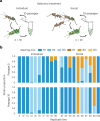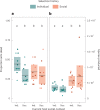Pathogen evasion of social immunity
- PMID: 36732670
- PMCID: PMC9998270
- DOI: 10.1038/s41559-023-01981-6
Pathogen evasion of social immunity
Abstract
Treating sick group members is a hallmark of collective disease defence in vertebrates and invertebrates alike. Despite substantial effects on pathogen fitness and epidemiology, it is still largely unknown how pathogens react to the selection pressure imposed by care intervention. Using social insects and pathogenic fungi, we here performed a serial passage experiment in the presence or absence of colony members, which provide social immunity by grooming off infectious spores from exposed individuals. We found specific effects on pathogen diversity, virulence and transmission. Under selection of social immunity, pathogens invested into higher spore production, but spores were less virulent. Notably, they also elicited a lower grooming response in colony members, compared with spores from the individual host selection lines. Chemical spore analysis suggested that the spores from social selection lines escaped the caregivers' detection by containing lower levels of ergosterol, a key fungal membrane component. Experimental application of chemically pure ergosterol indeed induced sanitary grooming, supporting its role as a microbe-associated cue triggering host social immunity against fungal pathogens. By reducing this detection cue, pathogens were able to evade the otherwise very effective collective disease defences of their social hosts.
© 2023. The Author(s).
Conflict of interest statement
The authors declare no competing interests.
Figures




References
Publication types
MeSH terms
LinkOut - more resources
Full Text Sources

